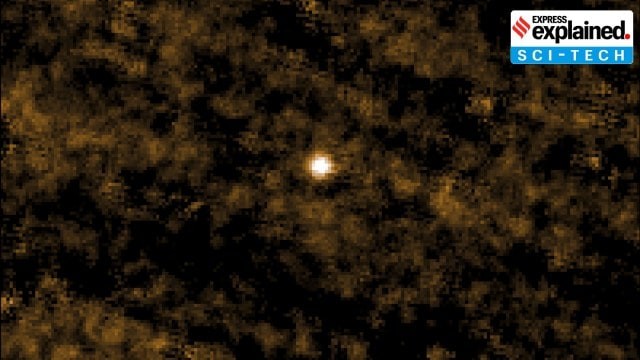Description

Disclaimer: Copyright infringement not intended.
Context:
- Scientists have spotted the heaviest antimatter nucleus ever detected lurking in a particle accelerator.
- The discovery of antihyperhydrogen-4, an antiparticle, could reveal an imbalance with its matter counterpart, offering insights into the origins of our universe.
What is Antimatter?
- Antimatter particles carry the same charge as matter particles, but of opposite sign.
- That is, an antiproton is negatively charged and an antielectron (positron) is positively charged.
- When matter and antimatter meet, they annihilate each other, releasing energy.
- This discovery revolves around an antimatter nucleus known as antihyperhydrogen-4.
Discovery of Antihyperhydrogen-4
- The antihyperhydrogen-4 particle consists of an antiproton, two antineutrons, and one antihyperon.
- The antihyperon contains a strange quark, distinguishing it from the simpler antiparticles.
- Scientists identified this particle in the particle tracks from around 6 billion collisions at the Relativistic Heavy Ion Collider (RHIC) at Brookhaven National Laboratory, New York.
Research and Methodology
- The RHIC experiment involved colliding gold ions at nearly the speed of light to recreate extreme conditions similar to those just after the Big Bang.
- By analyzing the collision data, researchers were able to identify signs of antihyperhydrogen-4.
- Out of the billions of collisions, approximately 16 nuclei of this exotic antimatter particle were detected.

Significance of the Discovery
For recognizing the Matter-Antimatter Asymmetry:
- One of the biggest mysteries in physics is why our universe is dominated by matter.
- According to theories, equal amounts of matter and antimatter should have been created during the Big Bang.
- The discovery of antihyperhydrogen-4 might help explain why this is not the case.
Details about Strange Quarks:
- The presence of a strange quark in antihyperhydrogen-4 provides an opportunity to study the behavior and properties of strange quarks, which are rare in ordinary matter but common in antimatter.
Testing Theories of Physics:
- The existence of such a heavy antimatter particle allows physicists to test predictions made by various models in particle physics and cosmology, potentially leading to new fundamental theories.

|
Aspect
|
Matter
|
Antimatter
|
Antiparticle
|
|
Definition
|
Composed of particles such as protons, neutrons, and electrons.
|
Composed of antiparticles, the counterparts of matter particles.
|
The counterpart to a specific particle in matter, with the same mass but opposite charge.
|
|
Charge
|
Usually positive for protons and negative for electrons.
|
Opposite to the charge of corresponding matter particles.
|
Opposite charge to its corresponding matter particle (e.g., positron for electron).
|
|
Existence
|
Makes up the observable universe, including stars, planets, and living organisms.
|
Rare in the observable universe, mostly found in high-energy environments like particle accelerators.
|
Exists in antimatter and can be produced in particle accelerators.
|
|
Interaction
|
Combines to form atoms and molecules.
|
Annihilates matter on contact, releasing energy.
|
Annihilates with its corresponding matter particle, resulting in energy release.
|
|
Examples
|
Proton, neutron, electron.
|
Antiproton, antineutron, positron.
|
Positron (antiparticle of electron), antiproton (antiparticle of proton).
|
|
Significance in Physics
|
Fundamental building blocks of the universe.
|
Helps study fundamental symmetries in physics.
|
Helps understand the nature of antimatter and the imbalance between matter and antimatter.
|

Conclusion
- The discovery of antihyperhydrogen-4 marks a significant milestone in particle physics.
- By studying this heaviest antimatter particle, scientists hope to unlock the secrets of the universe's origins and the fundamental asymmetry between matter and antimatter.
- This research not only deepens our understanding of the universe but also pushes the boundaries of current scientific knowledge.
Reference
https://www.livescience.com/physics-mathematics/particle-physics/scientists-discover-the-heaviest-antimatter-particle-ever-and-it-could-hold-secrets-to-our-universes-origins
KNOW IN DETAILS ABOUT- Einstein's General Relativity and Antimatter- https://www.iasgyan.in/daily-current-affairs/anti-matter
|
PRACTICE QUESTION
Q. With reference to the Antimatter nucleus, consider the following statements:
- Antimatter nuclei are composed of antiparticles such as positrons and antiprotons.
- The nuclei can be stable in the same way as matter nuclei in the right conditions.
Which of the above-given statements is/are correct?
A. 1 only
B. 2 only
C. Both 1 and 2
D. Neither 1 nor 2
Answer: A
Antimatter nuclei are not stable in the same way as matter nuclei; they tend to annihilate upon contact with matter, releasing energy in the process.
|














